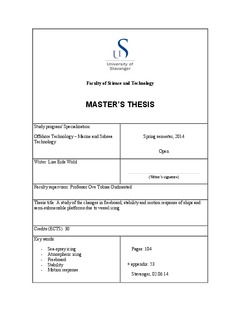| dc.contributor.author | Wold, Lise Eide | |
| dc.date.accessioned | 2014-09-16T09:01:15Z | |
| dc.date.available | 2014-09-16T09:01:15Z | |
| dc.date.issued | 2014-06-06 | |
| dc.identifier.uri | http://hdl.handle.net/11250/219834 | |
| dc.description | Master's thesis in Offshore technology | nb_NO |
| dc.description.abstract | There is an increasing demand for energy in the world, and as the traditional fossil fuel supplies are diminishing, it is pushing the oil and gas industry to seek for natural resources in remote and harsh environments. One of these distant and tough environments is in the Arctic region. Vessel icing from both sea-spray icing and atmospheric icing are common in these waters and can impact the safety of a platform or a ship in different ways.
Ice accumulation on vessels contributes to an extra load on the vessel and consequently there will be a change in the freeboard and stability. A reduction in one or both of these parameters can cause a vessel to capsize and sink. There have been numerous accidents in the past where small fishing vessels have capsized due to heavy icing. Scientists have discussed for years whether or not vessel icing is going to be a problem for larger vessel when considering the change in freeboard and stability.
Four different types of vessels were analysed in order to study the effect the ice has on dissimilar vessels, which are a fishing boat, a platform supply vessel, a drillship and a semi-submersible platform. Further, a case study and a parameter study have been undertaken for these vessels. The case study examines an icing event that could occur in the Barents Sea under a winter storm. The parameter study reveals the exact amount of sea-spray ice needed in order to make the vessels unsafe.
The calculated results revealed that icing accumulations had a significant impact on the freeboard, stability and motion response for the vessels. It was also calculated that the smallest ship, the fishing boat, was much more likely to lose its freeboard and stability due to vessel icing. This boat has a length of 23.10 m, which was three times shorter than the platform supply ship and almost ten times shorter than the drillship. However, the calculated amount of ice needed in order to make the two larger ships and the semi-submersible unsafe was so immense that such a situation is considered as highly unlikely to occur.
Further, this work also includes a proposal for further studies that can be done on this subject. | nb_NO |
| dc.language.iso | eng | nb_NO |
| dc.publisher | University of Stavanger, Norway | nb_NO |
| dc.rights | CC0 1.0 Universal | * |
| dc.rights.uri | http://creativecommons.org/publicdomain/zero/1.0/ | * |
| dc.subject | undervannsteknologi | nb_NO |
| dc.subject | offshore teknologi | nb_NO |
| dc.subject | Arctic | nb_NO |
| dc.subject | sea-spray icing | nb_NO |
| dc.subject | motion response | nb_NO |
| dc.title | A study of the changes in freeboard, stability and motion response of ships and semi-submersible platforms due to vessel icing | nb_NO |
| dc.type | Master thesis | nb_NO |
| dc.subject.nsi | VDP::Technology: 500::Marine technology: 580::Offshore technology: 581 | nb_NO |

